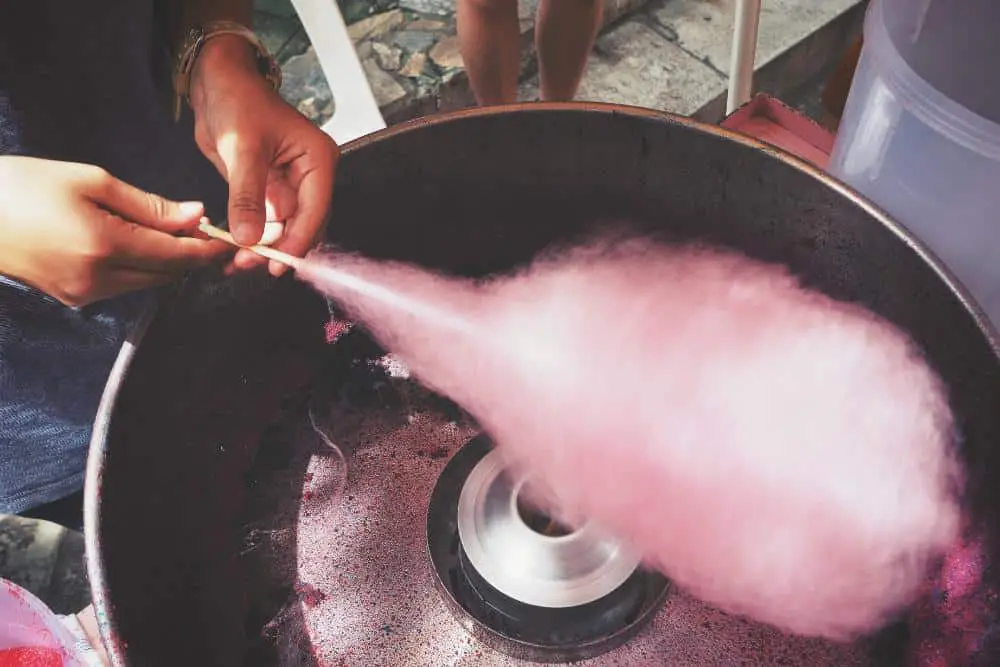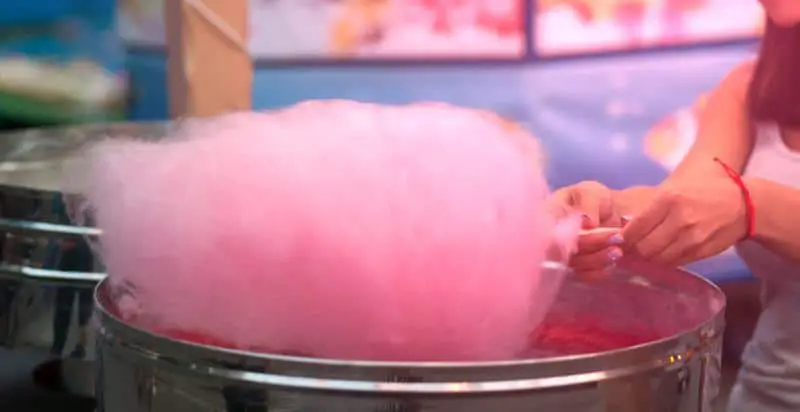Last Updated on May 28, 2022 by Jim Edwards
Cotton candy is one of the most popular and loved confections in the world. While the candy has amassed most of its recognition from the younger demographic, that doesn’t mean you won’t find adults stuffing their faces with this fluffy sugary goodness, even if only occasionally at carnivals and the like.
The candy has garnered love throughout the world across continents and countries, with the United States, China, Netherlands, England, Greece, and France being some of the places where it’s enjoyed most. This unanimous love and adornment for the sweet treat have made it a staple for sporting events, carnivals, state fairs, and other similar events.
But how did cotton candy come into existence? Who invented cotton candy? What is cotton candy made of? Have we got you curious yet? Join us as we dive deep into the world of this sugary cloud and attempt to answer all your questions about cotton candy.
Contents
Who Invented Cotton Candy?
Cotton candy was first discovered in Europe back in the 19th century, according to several reports. Spun sugar was a labor-intensive and expensive process and therefore, that was not readily available to the common individual at the time.
Others suggest that cotton candy dates back hundreds of years and originated in Renaissance Italy during the 15th century. At the time, chefs would melt and spin the sugar by hand because of a lack of technology. They used forks to extrude the candy into thin strands, which they then draped around broom handles. These hand-spun candies required quite a lot of labor, consumed a great amount of time and were also very expensive.
The cotton candy that we find at carnival stalls and sports events today, however, was not officially introduced until the late 19th century. Who invented this sweet treat, you ask? Well, this may come as a surprise to many but cotton candy was invented through the efforts of a dentist named Dr. William Morrison. A dentist inventing a candy, ironic right?
How Was the Sweet Treat Invented?

Dr. William Morrison partnered with John C. Wharton, a candy manufacturer, back in 1897 to develop the divine machine that would bless the taste buds of millions of people with the heavenly taste of this fluffed up cloud of sugar we call cotton candy.
The machine would melt sugar in a spinning bowl that had a perforated design with numerous minute holes. The sugar in the spinning, hot bowl caramelized and flowed through the perforations, forming light strands of melted sugar. Back then, the sweet treat was called “Fairy Floss.”
The two partners debuted their machine and the never-before-seen confectionery at the St. Louis World’s Fair in 1904. The two managed to sell a staggering 68,000 boxes for 25 ¢ apiece over the course of six months. The candy became so popular that a confectionery store bought the electric machine and began producing fairy floss a year later.
The first factory-made cotton candy machine was manufactured by Gold Medal Products in 1949. Cotton candy output improved as a result of this!
On September 6, 1905, Albert D. Robinson from Lynn, Massachusetts, filed a patent for an electric powered Candy-Spinning Machine. He sold the rights to the General Electric Company of New York in May 1907.
A similar cotton candy machine was invented in 1921 by a dentist from New Orleans, Louisiana named Joseph Lascaux. His patent gave the sugary treat the name “cotton candy,” which eventually superseded its prior moniker of “fairy floss” in popularity, though it is still known by that name in Australia.
A cotton candy machine was invented in the 1970s that manufactured and packaged the product, making it easier to make at carnivals, booths, and other events that required more mobile production.
Read -> Our Favorite Cotton Candy Machines
How to Make Cotton Candy
Using a Cotton Candy Machine
Normally, cotton candy machines have a spinning head which encloses a small bowl. First, you need to charge the bowl with sugar and food coloring or you could simply use colored sugar instead. The heaters at the head’s rim liquify the sugar, which is centrifugally pushed out through the tiny perforations.
When the fluffy, cotton-like strands accumulate on the inside walls of the bowl all you have to do is whirl a cone or stick along the rim of the bowl, catching the sugary strands into the cone or stick which are ready to be served. It is important to remember that since the candy is sensitive to humidity, especially when warm, the process can be messy and sticky in hot summer climates.
Also, it is worth noting that when using the machine to make cotton candy, you should only use the sugar or colored sugar that is specially milled with a crystal size and melting characteristics that are optimized for the machine. Using granulated sugar or rock sugar crystals can lead to the improper melting of the sugar.
Without a Machine
If you want to make this sugary delight at home but don’t have a machine, worry no more, we have just the right recipe for you. But first things first, following are some things you’ll need to make cotton candy at home:
- Sugar
- Corn syrup
- Salt
- Water
- Food coloring
- Parchment paper
- Cooking spray or vegetable oil
- Raspberry, lemon, almond, vanilla, or other extract or oil for flavoring
- Candy thermometer
Now that you have the ingredients, let’s get to cooking:
Step #1: Ready Your Workstation
To avoid problems with the hot, sticky sugar, cover the work area with plastic wrap or newspaper below the parchment paper. Also clear some counter or table space since you’ll need the space for spinning sugar on parchment paper.
Step #2: Combine Ingredients
Spray the saucepan or pot with cooking spray and add in a cup of corn syrup and water, 4 cups sugar, 1/4 teaspoon salt and let stir the mixture over medium high heat until they have melted. To prevent sugar crystals from forming, wipe down the sides of the pan with a pastry brush.
Step#3: Heat the Mixture
Heat the mixture above to 320 degrees Fahrenheit, use the candy thermometer to maintain the temperature. Once the mixture reaches the temperature, pour it into a shallow heat-proof container. Stir in the extract and food coloring until everything is completely mixed. While the recipe uses pink food coloring and raspberry extract, you may use any extract or food coloring you like.
Step #4: Spin the Sugar
Dip your whisk into the mixture and then swing it back and forth quickly with the whisk a foot above the parchment paper until very thin strands of sugar begin to fall on the paper. Repeat a couple more times until you have a spun sugar nest sizable enough to quench your sugary thirst. It may appear a little messier than traditional cotton candy, but it will taste just as good.
Step #5: Serve and Enjoy!
Wrap the candy strands over a stick or pack them into a cone, serve and enjoy them however you want to.
The Divine Sugary Treat Comes in More Than One Flavor!

Cotton candy comes in two main flavors: pink vanilla and blue raspberry. However, do not mistake the color of the candy as an indication of their flavor. Color has been separately added to the sugar to produce ionic colors in this sweet. It is up to the confectioner to choose the color of their delicacies. Erlosky blue and allura red are two common food colors used in cotton candy.
Contrary to popular belief, cotton candy comes in more than just the two above-mentioned flavors. Cotton candy is essentially flavored sugar, as such, there are endless possibilities to the flavors this candy can have. Green apple, mint chocolate, and even grape flavors are available if purchased from the right vendor.
The Many Names of Cotton Candy
Although the confection is more popularly known as “cotton candy,” there are different places in the world that have a different name for the heavenly delight. Following are some of them:
- Greece
Old Ladies’ Hair
- China
Dragon’s Beard
- Netherlands
Sugar Spider
- England
Candy Floss
- France
Papa’s Beard
How to Make COTTON CANDY Using a Blender At HOME
Learn how to make cotton candy at home using only a blender and some easy-to-find ingredients. A simple, fun, and time-effective recipe!
Summary
Cotton candy is one of the most popular confections in the world and for good reason. People of all ages, from kids to adults, love stuffing their faces with this sticky, sugary delight, making it a staple for traditional family events and outings. If you ever have a craving for sugar, this heavenly cloud of sugar is all you need!
Cotton Candy – Frequently Asked Questions (FAQs)

How Do You Use a Cotton Candy Machine?
This is how you can use a cotton candy machine:
- Fill the candy reserve bowl with sugar
- Turn on the machine from the main switch
- Turn up the heat using control knob
- The machine should start creating cotton candy strands
Can You Make Cotton Candy without a Machine?
Yes, you can, to learn more, read the sections above!
How Much Is a Cotton Candy Machine?
Depending on the size and capacity of the machine, it can cost you anywhere between $200 and $2000.
How Do You Clean a Cotton Candy Machine?
A cotton candy machine can be cleaned by following these steps:
- Unplug the machine and allow it to cool
- Remove the cover and bowl
- Wash both parts with soapy warm water.
- Thoroughly rinse and dry
- Reassemble the machine and plug it in.
Where Can I Rent a Cotton Candy Machine?
There are various online rental services offering rental cotton candy machines. Just head over to google and search for “rental cotton candy machines near me” and choose the service with the best customer reviews.
What Is Cotton Candy Made Of?
The four main ingredients of cotton candy are:
- Sugar
- Water
- Corn syrup
- Food flavoring and color
Related Articles
The Top 8 Candy Brands You Should Try
National Candy Day – The Day Your Sugary Fantasies Come True
Werther’s Original Candy – A Complete Guide!
I’m Jim Edwards and I started this website to share my love of Junk Food. We cover new junk food, desserts, snack foods, fast food secret menus, candy (of course!) and other related news. We love trying “secret menus” at restaurants. And we love trying new products too. So, we are trying to have some fun with our hobby and share some useful information with you, our community. Please feel to send us your suggestions and feedback through the contact form. And if you have products you would like us to try, let us know…!
